mytest
eBooks, Books, and more from ARUDOU Debito (click on icon):
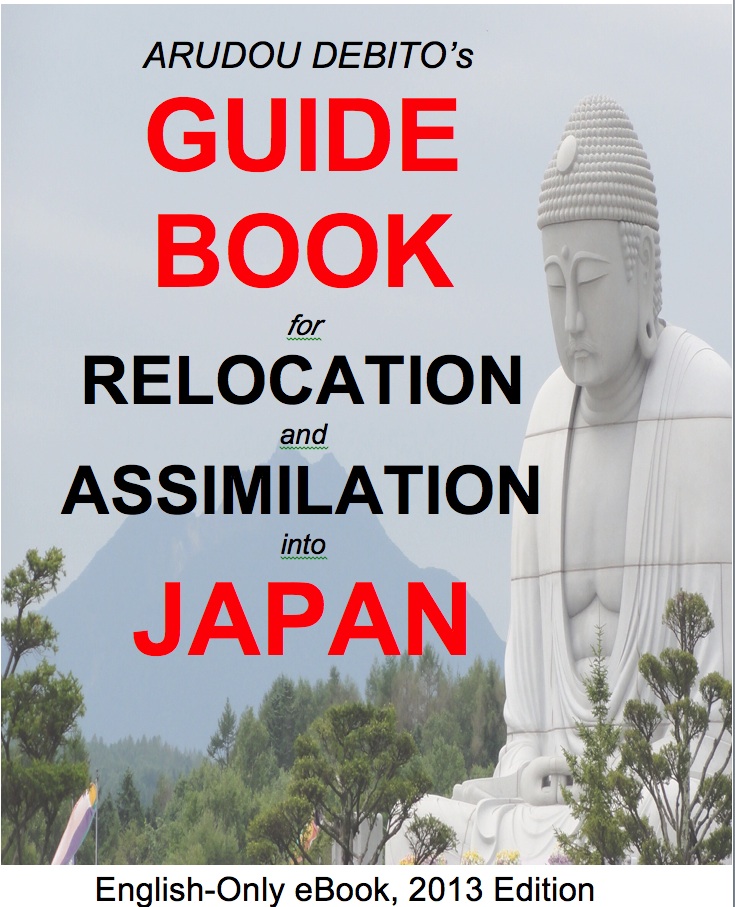
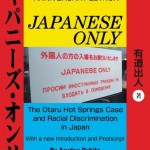
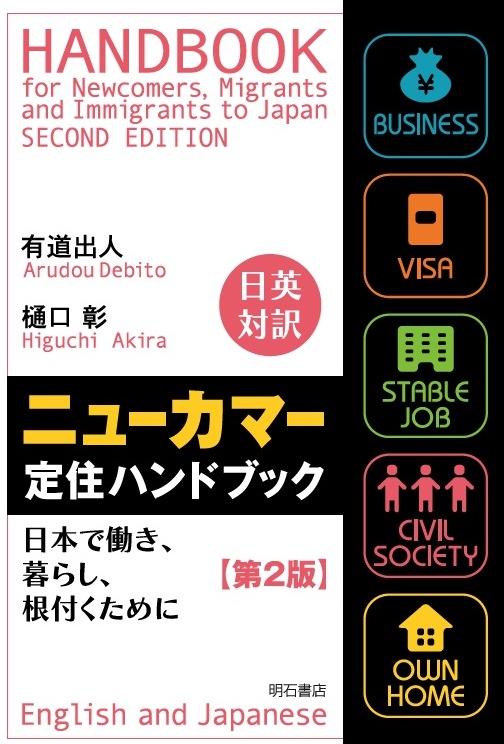


![]()

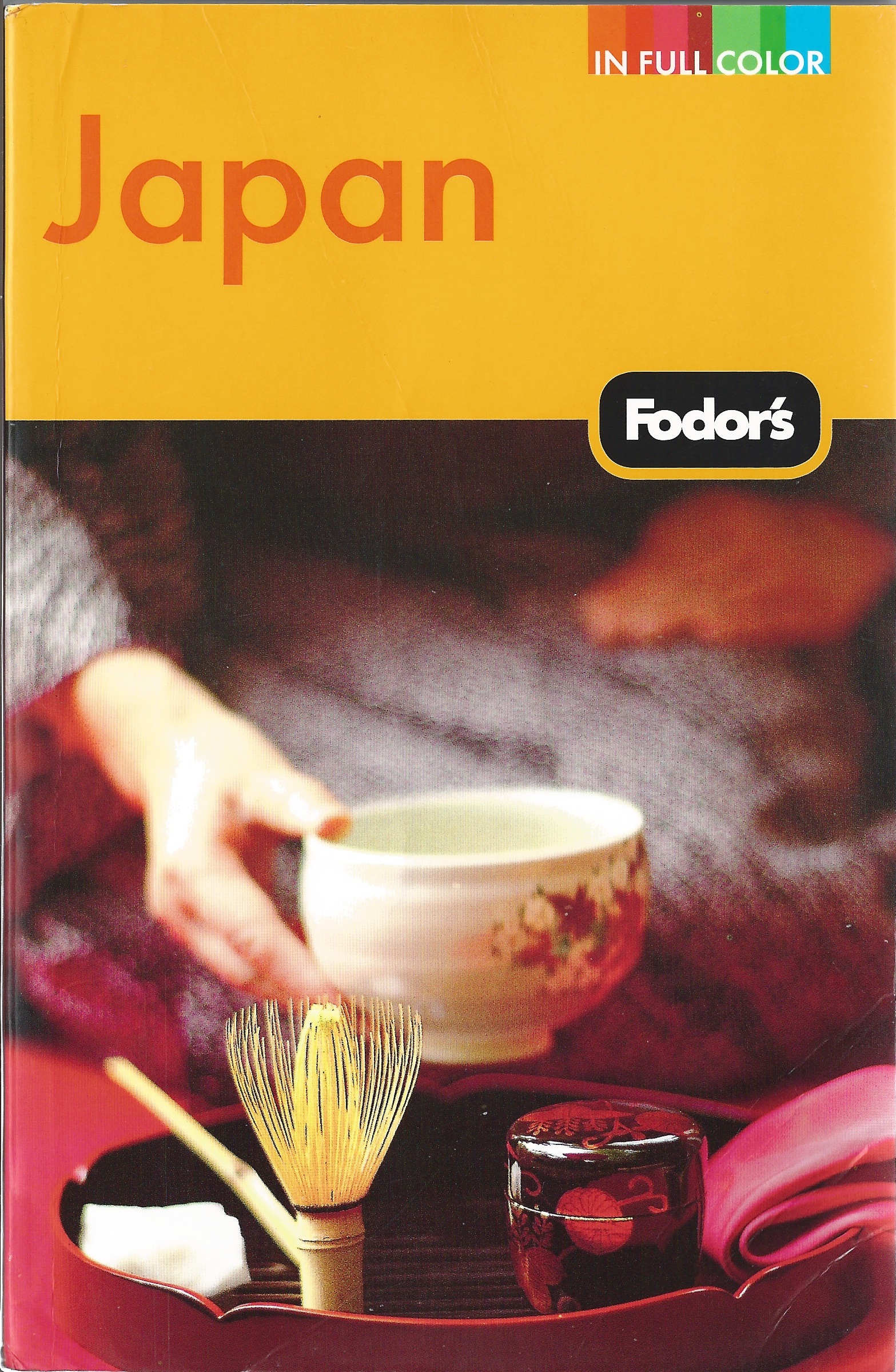
UPDATES ON TWITTER: arudoudebito
DEBITO.ORG PODCASTS on iTunes, subscribe free
“LIKE” US on Facebook at http://www.facebook.com/debitoorg
http://www.facebook.com/handbookimmigrants
https://www.facebook.com/JapaneseOnlyTheBook
https://www.facebook.com/BookInAppropriate
Hi Blog. Sorry for the longish absence. I’ve been working on a big writing project, and I’m happy to say I got it ready on time and under budget.
A few days ago KAJ, the editor of MRbloggen, a Norwegian human rights blog, sent me a very insightful article on racial profiling and foreign crime reportage in Japan. Let me excerpt:
//////////////////////////////////////////
Racial Profiling in Japan: Why do Japanese Fear Foreign Crimes?
<Posted by Kiki A. Japutra, Editor/Redaktør>
On 26 May 2013, a large mass demonstration demanding the eradication of foreign crimes and the expulsion of illegal immigrants was commenced in Tokyo. The demonstration ran for approximately two hours (between 11:00 – 13:00) starting from Shinjuku Park. In a statement calling for participation of the Japanese public, it was noted that “this demonstration is not a demonstration against foreign crime specific. It is a demonstration for the expulsion of all bad foreigners” [translated]. The procession of the demonstration can be viewed here. This is not the first time such mass distress against foreign crimes occured. So the question that should be asked is, is foreign crimes really a problem in Japan? What may have caused Japanese to fear foreign criminals?
Japan has been known for its media frenzy that focuses on the rising number of crimes committed by foreigners coming into the country. Some have argued that the phenomenon occurred due to the fact that the number of crimes committed by foreigners have been disproportionately higher than those committed by Japanese nationals. This has resulted in the stereotyping, criminalisation of certain nationalities, and countless acts of discrimination against non-Japanese nationals.
The increase of crime reporting in the news media is argued to be one reason for the growth of public anxiety and the fear of crime, and the Japanese media plays a central role in creating the image of a “sick society”. Japan Today, for example, writes that:
[b]efore 1989, foreigners tended to be convicted at the rate of about 100 per year. But from the 1990s, the figure showed a marked rise and from 1997 onwards, posting consecutive year-on increases. By 2003, Japanese prisons held some 1,600 foreign inmates, making up roughly 5% of the total prison population. […] In 2010, foreigners were said to account for 3,786, or 4.4% of the total prison population. New arrivals that year included 195 Chinese nationals, followed in descending order (figures not shown) by Brazilians, Iranians, Koreans (both north and south) and Vietnamese.
Such a report in the news media is not uncommon in Japan. Some have argued that how the public reacts towards an incident is entirely shaped by their perspective and attitude towards a certain issue. In the case of Japan, the discrimination, and later criminalisation, of non-japanese nationals are influenced by the image incubated by the Japanese media about how foreigners are the cause of the constant raising of crime in Japan, and that certain nationalities are responsible for certain types of crimes. Such stereotyping of crime is also known as racial profiling.
How can we explain the hostility of the Japanese media towards foreign crime and foreigners in general? Mary Gibson explains in her book Born to Crime (2002) that “[a] succession of ‘Moral Panics’ offered opportunities for interest groups to shape criminal justice policy”. Citizens are more likely to support government’s means of social control (including laws and policies) if and when the government successfully soothes public’s anxieties and insecurities about crime. In other words, media acts as a tool to build public’s confidence in and support to the government.
////////////////////////////////////
The rest of the article is at http://mrbloggen.com/2013/06/11/racial-profiling-in-japan-why-do-japanese-fear-foreign-crimes/, so have a look.
I have incorporated this information into my writing. Have a read. Arudou Debito
/////////////////////////////////////
Differentiated crime statistics in Japan for Kokumin and “Foreigners”
The NPA’s annual White Papers on crime illustrate how crime reportage in Japan is differentiated into “kokumin versus gaikokujin”, with no comparison between them in scope or scale:
(Figure 1: NPA kokumin crime statistics, 1946-2011, courtesy Ministry of Justice at http://hakusyo1.moj.go.jp/jp/59/nfm/mokuji.html (accessed June 11, 2013). The left axis is the rate of incidents of crime, the right axis the number of people involved in cleared crimes. The top layer of blue vertical bars are all cleared cases of penal crimes including fatal or injurious traffic accidents. The center layer of yellow vertical bars are cleared cases of penal crimes including theft. The bottom layer of purple vertical bars are regular violations of the penal code excluding theft or traffic accidents. The top red line is the rate of all penal code violation incidents including traffic incidents. The second blue line is the rate of regular penal code violation incidents not including traffic incidents. The three bottom dotted lines are, from top layer bottom, numbers of perpetrators for all penal code violations (red), numbers of perpetrators for penal code violations not including traffic accidents (blue), and numbers of perpetrators for penal code violations not including traffic or theft.)
(Figure 2: NPA statistics for crimes by foreign nationals, 1980-2009, English original, courtesy Ministry of Justice at http://hakusyo1.moj.go.jp/en/59/nfm/n_59_2_3_1_2_1.html#fig_3_1_2_1 (accessed June 11, 2013). The terminology, according to the MOJ (http://hakusyo1.moj.go.jp/jp/59/nfm/n_59_1_2_0_0_0.html): “Visiting foreign nationals” is a direct translation of rainichi gaikokujin, and refers to foreigners who are not “Other Foreign Nationals” (sono ta no gaikokujin) Permanent Residents, Zainichis, or American military on bases in Japan. After comparison with NPA charts below (cf. Figure 3), this chart does not include visa violations.)
Note the difference in scale. Comparing a base year of 2009 (H.21), there were a total of 30,569 total cleared cases of crime committed by all foreign nationals (blue plus red bars). For kokumin, corresponding thefts and regular penal offenses not including traffic violations (purple bar, on a scale of 万件) total to over 1.5 million cases, or a difference of about a factor of 49. If put on the same chart with the same scale, foreign crime numbers would thus be practically invisible compared to kokumin crime numbers. However, the NPA has chosen to avoid this comparison, focusing instead on the rise and fall – mostly the purported rise – of foreign crime.
The effects and externalities of propagandizing “foreign crime”
Herbert (1995: 196-228) traces the arc of NPA White Papers after they introduced a new term into Japanese crime reportage from 1987: rainichi gaikokujin (“visiting foreign nationals”) indicating a new breed of “foreignness” in Japan (separate from Zainichi, American military and dependents within US bases in Japan, etc.) as a byproduct of Japan’s “internationalization” and foreign labor influx. Herbert notes that the tone, particularly in the NPA’s 1990 White Paper special on “rapid increase in foreign workers and the reaction of the police”, “functions to suggest that ‘illegal’ migrant laborers were involved” (197). This led to a “prompt media echo” and a “moral panic” (Gibson 2002) of a purported foreign crime wave that, in Herbert’s assessment, was “rash and thoughtless” (ibid). In a thorough recounting and analysis of media reaction, Herbert concludes that police reportage and media reaction successfully aroused suspicion and criminalization of non-citizens, where Japan as a nation was portrayed as “defenseless against international crime” (198). This also set a template for future NPA campaigns against “foreign crime” that would manipulate statistics, incur periodic moral panics in the media, and justify budgetary outlay for bureaucratic line-item projects (Herbert: 179).
By the 2000s, the NPA had normalized statistical manipulation to create perpetual “foreign crime rises”. As only a few examples: On May 1, 2000, the Sankei Shinbun cribbed from the NPA’s April periodic foreign crime report a front-page headline: “Foreign Crime Rises Again, Six-Fold in Ten Years;”[1] the small print was that this rise was in only one sector of crime, which had a comparatively small numbers of cases compared to cases committed by citizens. The NPA announced in their September 2002 periodic foreign crime report that the number of crimes committed by foreigners on temporary visas had jumped by 25.8% on the previous year, and serious crimes like murder, robbery, and arson likewise were up 18.2%. Despite rises in crime numbers committed by kokumin in the same time period (see chart above, H.10), the mass media headlined not only that foreign crime had increased, but also that foreigners are three times more likely than Japanese to commit crimes in groups.[2] Regarding latent foreign criminality, the NPA made the following argument within a 2010 news article: “The number of foreigners rounded up last year on suspicion of being involved in criminal activities was about 13,200, down roughly 40% from 2004 when the number peaked. ‘The extent of how much crime has become globalized cannot be grasped through statistics,’ the [NPA White Paper of 2010] says, attributing part of the reason to difficulties in solving crimes committed by foreigners—which are more likely to be carried out by multiple culprits than those committed by Japanese.”[3] In other words, even if “foreign crime” numbers are smaller than “Japanese crime” numbers, the NPA claims there must be a statistical understatement, because the latent “groupism” of “foreign crime” causes discrepancies when compared to “Japanese crime” (countering the stereotypical meme seen in Nihonjinron etc. of “Japanese groupism”).
Moreover, as seen in police notices, the NPA was claiming “rapid rises” (kyūzō) in foreign crime when foreign crime rates and numbers were concurrently decreasing. Even after “foreign crime” numbers eventually dropped below any reasonable NPA excuse of statistical discrepancies or pinpoint rises in types of crime, the NPA widened the scope of its sample to make it appear as though non-citizen crime had still risen. Compare the scale of its 2001 statistics (issued April 1, 2002) when non-citizen crime had plateaued, with 2012’s (Figures 3 and 4), when it had significantly dropped:
(Figure 3: Crime statistics for “foreign crime” 1991-2001, chart from April 2002’s NPA semiannual report on “foreign crime.” The black portion of the bar chart is numbers of visa violations, the grey portion numbers of criminal violations, and the black line the total number of non-citizen perpetrators. Courtesy Arudou Debito, JAPANESE ONLY (2006).)
(Figure 4: Crime statistics for “foreign crime” 1982-2011, chart from April 2012’s NPA semiannual report on “foreign crime”. The blue portion of the bar chart is numbers of visa violations, the yellow portion numbers of criminal violations, and the red line the total number of non-citizen perpetrators. Courtesy www.npa.go.jp/sosikihanzai/kokusaisousa/kokusai/H23_rainichi.pdf.)
2011’s numbers have dropped below 1993’s numbers. So from 2007’s semiannual crime report the NPA shifted the scale back behind 1993 to show a rise compared to the past (similar to how Sankei Shinbun above depicted a six-fold rise in 2000, by comparing numbers to a decade earlier). There is no deflator to account for the fact that the non-citizen population was before 1990 less than half that of 2011.
[1] “Gaikokujin hanzai futatabi zōka: 10 nen de 6 bai ni.” [Foreign crime goes up again: Six-fold in ten years] Sankei Shinbun, May 1, 2000.
[2] See inter alia Arudou Debito, “Generating the foreigner crime wave.” Japan Times October 4, 2002; Arudou Debito, “Time to Come Clean on Foreign Crime: Rising crime rate is a problem for Japan, but pinning blame on foreigners not the solution.” Japan Times October 7, 2003.
[3] “NPA says foreign crime groups increasingly targeting Japan.” Kyodo News, July 23, 2010.
ENDS
//////////////////////////////////////////////////
UPDATE JUNE 24, 2013:
Debito.org Reader DR sends us a link from the Shizuoka Prefectural Police website, where the url is, indicatively, entitled “gaijin hanzai”. In this screen capture we see this cute little chart:
Not only is the chart hard to read (the undifferentiated bars are numbers of Gaijin committing crime, but you have to look at the bottom numbers to figure out that the green bar is visa violations (which Japanese cannot commit), and the light blue bar is for non-visa-related crimes. Same with the yellow and red lines respectively for number of Gaijin crimes committed. Note how since 2004 the number of NJ committing any kind of crime is on a downward trend, as are visa violations.
But what gets rendered in red? The jagged line to show rises. Gotta keep that Gaijin scare on.

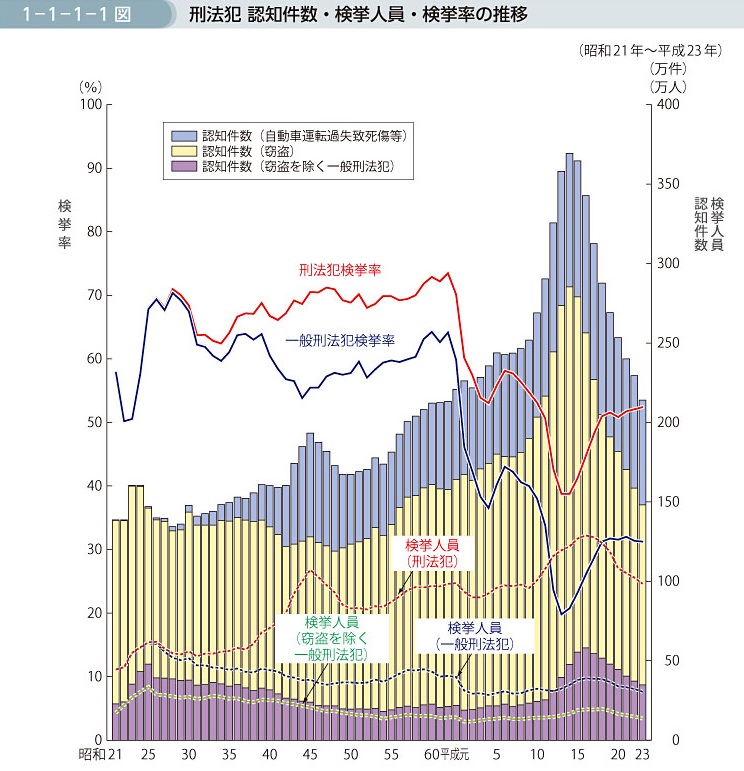

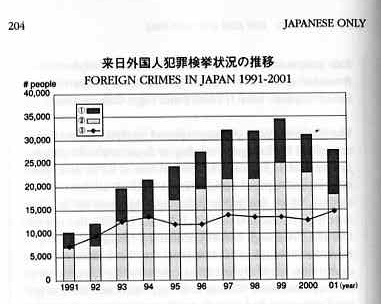

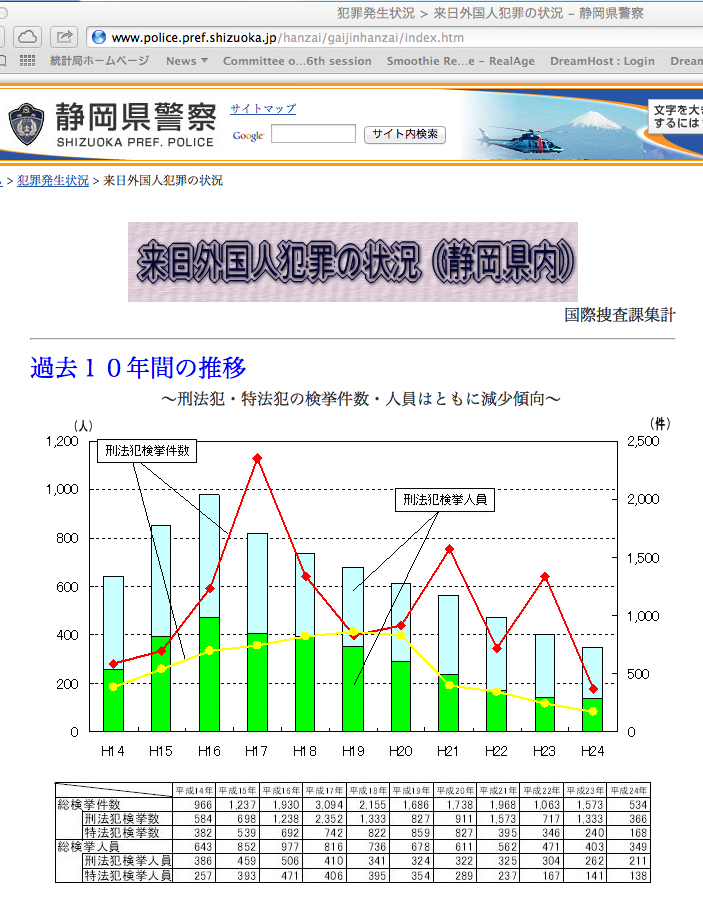
23 comments on “KAJ and Debito.org on foreign crime and racial profiling in Japan: statistical hocus-pocus”
‘Japan’s not institutionally racist’, I can hear them crying ‘it’s just a different culture’.
It’s almost poetic. NPA says something like “In 2011 there were two cases of foreigners stealing purses.” and then says “In 2012 there were eight cases of foreigners stealing purses.” The Japanese media says “FOREIGN CRIME EXPLOSION, INCREASE OF FOUR HUNDRED PERCENT IN ONE YEAR!!!!” and runs news stories about it for two weeks straight, complete with spots on Jippu every morning asking foreigners “How much more dangerous is your country than Japan?” and cutting all the answers they don’t like, and I’m sure a special on gun crime in America will be thrown in for good measure as well.
Fact: foreigners in Japan are one of the most docile population groups on the entire planet. If Japan is “safety country” then we are the very definition of “safety minority”, and as Debito has shown here, Japanese citizens are many many times more likely than noncitizens to commit crimes, even more so if you take temporary visitors out of the picture.
Weird how Japanese authorities think illegal immigrant equals dangerous criminal. Remember, an illegal immigrant is simply someone who overstayed their visa, hardly a violent crime. I remember being stopped for an ID check by a policeman, and when I protested, he replied: “Look, there’s a huge number of illegal immigrants in Japan, they’re DANGEROUS!”. My thought was: “Uh, no.. they overstayed their VISA. How does overstaying my visa suddenly make me dangerous??”.
Their logic completely baffles me. And frankly, these days I’ve felt more nervousness walking down a dark alley with Japanese lurking in the shadows than with foreigners. Generally speaking, I feel more safe around foreigners than around Japanese. I’ve lost count of the number of times I’ve been creeped out by shifty eyes looking at me, or by being approached by some weirdo with a hidden motive.
of course they don’t mention mass crimes by Japanese against NJs, e.g. human trafficking, which Japan remains a major destination for.
http://www.humantrafficking.org/countries/japan
Its so bad all you need to do is type in “Japan human” on google and it comes up almost right at the top of the list.
“Japan is recognized as having one of the most severe human trafficking problems among the major industrialized democracies.4 Japan is a destination country for women and children from East Asia, Southeast Asia, and to a lesser extent, Eastern Europe, Russia, and Latin America who are subjected to sexual and labor exploitation.5″”
Welp,
Jippu are already running endless reports about the demonstrations in Istanbul (how convenient for Tokyo’s bid),plenty of junk about “world famous” Japanese celebrities, and NOTHING on racist demonstrations in Japan.
— Please send us a link for example.
‘The Japanese government has taken modest, but overall inadequate, steps towards enforcing laws against trafficking. The government reported 19 investigations for offenses reported to be related to trafficking, resulting in the arrest of 24 individuals in 2010. The government convicted 14 of these individuals for various trafficking-related offenses, with penalties ranging from only a fine to jail sentences of one to 4.5 years. The government investigated only three cases of suspected forced labor during 2010 but failed to arrest, prosecute, convict, or sentence to jail any individual for forced labor.16
“Additionally, the government fails to address government complicity in trafficking offenses.”
What a surprise.
Once again the English language takes a kicking at the hands of the alarmists.
a “large mass demonstration” took place on the 23rd of May, according to Japutra. Is that “mass” as in the 100,000 currently demonstrating against the World Cup in Rio de Janeiro? Or as in the tens of thousands demonstrating in over seventy cities in Turkey, where three have been killed and over 4,000 injured?
No, it’s a “large mass demonstration” as in one hundred and forty-one (I counted them twice, and strayed on the side of generous) losers in downtown Tokyo, approximately 0.00108% of the metropolitan population, or 0.0008% of the entire Japanese population.
I’ve said it before, but the more the idiot trouble-makers are allowed to get away with sensationalist nonsense like this, the worse anti-racists appear in the eyes of normal Japanese. The alarming, but not especially exciting news about the police twisting crime figures disappears in miasma of hyperbole and bull. And nobody questions it for a bloody minute.
@Andrew in Saitama
Don’t hold your breath. This is the same Welp whom Debito asked for proof of his imaginary “warning posters against interracial marriage” which, apparently, can be seen all over Fukuoka.
It’s not going to happen, is it?
@ Joe #7
But the Japanese press, and the Japanese love to see civil disturbances in other countries! For them it’s proof that Japan is ‘harmonious’, and I believe that this thinking goes a long way towards why the Japanese rarely show their disappointment with bad governance (‘Not in front of the gaijin, please!’). I remember one Japanese colleague who harangued me every day for a week about how demonstrations in England were contrary to his image of ‘the English gentleman’. He thought that I should be embarrassed by this. I told him that the UK people would never tolerate a government that managed a nuclear disaster the way the Japanese government was. Needless to say, it all went straight over his head. Yes, ‘ganbaru’ culture has a lot to answer for; a cunning plan to indoctrinate the Japanese into believing that suffering silently is proof of Japanese cultural superiority.
This is one of the reasons why Abe and his resurgent J-nationalism is so dangerous; if (as a Japanese) you are not one of those who has bought into it, you are likely to pride yourself on not speaking out against it.
@#7
You’ll have to forgive me for not pulling out my phone and snapping a picture at the time (I don’t even live in Fukuoka prefecture so I don’t often have the chance to visit), however if you’re going to attack me, you’d do best to at least properly quote me: “The best are the “beware of fake marriages” signs that pop up on trains in Fukuoka occasionally, complete with picture of big-nosed foreigner making an angry face and a crying female J-spouse victim.” The signs have occurred *occasionally* and *on trains*, and while I’ll admit that “scam marriages” are just as much of a problem as anyone else, my problem is with the racist caricature involved rather than the content – though they should have probably used a Japanese male and foreign female in the specific example I was speaking of.
Now that said, considering these examples:
http://www.police.pref.kanagawa.jp/images/h0/h0001_03.gif
http://image.blog.livedoor.jp/kankyotoshisetsu/imgs/c/9/c9eaf02e-s.jpg
http://image.blog.livedoor.jp/kankyotoshisetsu/imgs/3/1/318b27b8-s.jpg
… are just the first few relevant hits off of a Google image search for 偽造結婚, if you can’t imagine that someone – either with or without permission – may have put posters up on trains in Fukuoka warning people about fake marriages, then I seriously don’t know what to tell you.
Back to the point, we can’t well provide “links” to Jippu content as it is a television program, but anyone with access to a digital-capable television and some free time between 7:20 and 7:40am Mon-Sat will be readily able to verify the content of show at their own leisure.
@Jim (#8) Exactly – demonstrations and strikes are used by the J-Media to show the Japanese public how “broken” and “dangerous” the Western countries are, and used as proof that democracy “doesn’t work” – the “Japanese way” has won again. Of course, only the most violent outbursts, burning cars, etc. is shown, never the peaceful protests.
This is nothing but else but propaganda and it works pretty well in a country where only a minority of people seem to be able to think critically. Lately, I often get asked “what I think” about the demonstrations in Turkey and Brazil, and when I say that “I think” it is a good thing if people act out their democratic rights, the reaction I get most is an incredulous “Eeeeee”, and I feel that this kind of thinking is too wide a gap for the Japanese to bridge.
I wonder if this is due to a lack of imagination and experience of true democracy, because in Japanese history, protests and uprisings against the government (especially during the Shogun rule) always led to death, chaos, and the situation of regular people getting even more dire than before. There is simply no common experience of protests that worked out and led to an improvement. I think one of the reasons why the J-education system and media work towards the “sedated” society we witness today is this knowledge that if the Japanese public ever got wise and saw through their oppressive system, all hell would break loose. I don’t see the possibility of a peaceful revolution in Japan, and the longer it takes the more radical it will be. But who knows how many hundred years more it will take.
Loved your post as I do many of your WONDERFUL articles.
The way they apply death penalty in Japan also ammounts to severe torture. They got 29 national remarks on their death penalty system during the last Universal Periodic Review (2012-2013) at the Human Rights Council in Geneva.
Next week ther will probably have a batch of executions. Why don’t you write something about it?
— Thanks. The Death Penalty isn’t quite a Debito.org issue (as it’s not targeting NJ in particular, and plenty of other sites talk about it). In any case, please send us a link to the UPR HRC report.
One only has to watch the TV news to see how the public perceptions are manipulated. Notice how there is regularly a report of a bizarre crime (good entertainment value) from overseas, complete with security camera footage and police mugshot (reinforcing the “foreign-ness of the perpetrator); at the same time, equally violent or disturbing domestic crimes are quickly noted (where’s the security camera footage?), and often with no mugshots even if there is an arrest, before moving on to food, fashion or sport.
The visuals – what the average viewer is more likely to remember – reinforce the connection between “foreigner” and “criminal”.
And one has to question the rationale of reporting a bizarre convenience store holdup (or whatever) in [insert country here], while not covering demonstrations held in Japan’s largest cities. (Using Joe @ #7 figures, “approximately 0.00108% of the metropolitan population, or 0.0008% of the entire Japanese population” involved in protests in Tokyo vs. 0% of Japan’s foreign population involved in bizarre crime overseas)
Except, of course, to keep the dream in “dreamy day” alive…
@Welp #9
Interesting images and thanks for the links, but none of them are posters warning against fake marriages. The one the left doesn’t actually refer to marriage (unless my eyes are worse than I thought), so we can discount it.
The second one looks pretty shocking at first, and it would be if you came across it on a train, but it’s not a poster; there’s no reference to any organisation or a phone number. I’d imagine it was designed by some sad little geek who can’t get a girlfriend who sits in front of his computer seething with jealousy at the thought of some foreigner getting his hands on what he can’t. Notice that the backgrounds of the first two images are exactly the same. I’d bet neither exists outside of cyberspace.
The third one is a poster, but it’s not a warning about fake marriages; it’s clearly aimed at groups ranging from sleazy nightclub owners to the Yaks to human traffickers and their potential victims (hence the foreign languages), emphasising that certain activities are illegal in Japan, however they may appear to be a convenient way to smooth out the process of acquiring a visa. One of those may happen to be a bogus marriage, but it’s hardly the same as a “beware fake marriages” poster.
@Joe You posted under the wrong entry. I don’t see a claim that these are the posters Welp reported on the other day. Have I missed that?
Joe, you have to be trolling, right?
Under no definition I’ve ever seen does the absence of a phone number or organization name disqualify a poster as a poster. It’s also richly ironic that you attempt to portray the second poster as illegitimate because it might exist primarily on the internet. Under your logic, your own argument is marginal and illegitimate. (Awaiting the response that you were writing on a smartphone and have a girlfriend, therefore your logic is sound.)
A poster that says その行為は犯罪です!偽造結婚 is clearly a poster warning against fake marriages. The fact that there are more warnings in addition to this makes it more racist rather than less. I’d like to hear a non-discriminatory/non-essentialist moral argument that can justify 家庭内別居 but not 偽造結婚.
You may be able to make a cogent argument, but nothing you say in your un-empirical last post rose against the level of saying “nuh-uh.” If you have a better rebuttal, I’m waiting for it.
@Markus
No.I was replying to Welp (#9). I still dispute the idea that posters telling people to “beware” fake marriage have ever appeared on trains in Fukuoka, on the grounds that I’ve never seen one in over twenty years travelling by train six or seven days a week, and that such a poster wouldn’t make sense. Again, who would it be aimed at?
@XY
No.I’m not a troll. I guess I’m just a bit of a nerd linguistically who likes to get things straight in my own mind at least.
No, of course the absence of a phone number/contact address doesn’t disqualify something as a poster. My daughter’s bedroom wall is plastered with “One Direction” posters; not a single clue amongst the grinning, idiot faces as to who produced them. BUT posters on trains that are designed to inform or persuade (and surely that’s what we’re talking about here), always have some kind of information relating to the source. Always. If you disagree, I’d ask you to find a link to one that doesn’t (and I don’t mean some bizarre, “mystery” ad campaign). Fair enough?
Secondly, the reason why the first two images provided by Welp aren’t posters is that they don’t exist outside of cyberspace. (Again, if you can prove me wrong with a link to photo, then be my guest.)
Real-life posters are so beloved by advertisers and politicians because the public can’t escape them; you plaster a wall with a hundred pics of politician A or deodorant B, and every passer-by is going to see them, willy-nilly. If you actually have to do an internet search for a particular image then we’re no longer talking about a “poster” but a “design” or an “image”. Very different.
It’s of personal interest to me because I use JR Kyushu, Nishitetsu and the Fukuoka Underground so often. If I thought for one second that they were accepting “posters” like those images provided by Welp and allowing them to be displayed on their trains, I’d be horrified to the point of wanting to leave Japan.
But I’m confident they’re not. 100 % : )
Joe, you seemed to have almost entirely ignored what I wrote in your insistence over the “do those posters exist?” issue. I can certainly appreciate your skepticism and what not, but again, in the absence of physical evidence from the encounter in question I merely attempted to show that such posters *can* exist. You are of course free to accept or not accept that fact, though I hope in the future you will pay more attention to peoples’ entire comments rather than just building straw man arguments from choice pieces of them.
I believe that these kinds of posters are real. They certainly are prevalent in Osaka. I don’t think burying your head in the sand and saying “I’ve never seen them so they don’t exist” is any way to make progress on NJ rights. To me, it smacks too much of blaming the victim and apologism.
I have also seen a lot of posters without contact info plastered all over subway cars giving out all sorts of weird info, so reports of xenophobic posters anonymously posted on trains doesn’t surprise me in the slightest. I’m surprised that Joe finds these things such a novelty. Fukuoka must be a different country!
I still don’t know who is a provider of nasty posters, and I haven’t seen them on the train yet. So I don’t know what is going on out there. But, I am not surprised that people begin to see such nasty posters in the newspapers or magazine ads in real. It shouldn’t be dismissed as a minor issue, since they are appearing in computer media, communicating widely among people associated with xenophobic groups (i.e., Zaitokukai) nationwide.
UPDATE JUNE 24, 2013:
Debito.org Reader DR sends us a link from the Shizuoka Prefectural Police website, where the url is, indicatively, entitled “gaijin hanzai”. In this screen capture we see this cute little chart:
Not only is the chart hard to read (the undifferentiated bars are numbers of Gaijin committing crime, but you have to look at the bottom numbers to figure out that the green bar includes visa violations (which Japanese cannot commit), and the light blue bar is for non-visa-related crimes. Same with the yellow and red lines respectively for number of Gaijin crimes committed. Note how since 2004 the number of NJ committing any kind of crime is on a downward trend, as are visa violations.
But what gets rendered in red? The jagged line to show rises. Gotta keep that Gaijin scare on.
Shizuoka Kenkei, remember, is the organization that provided the general public with that racist prevention of Gaijin Crime manual back in 2000.
Good lord.
http://www.pref.shizuoka.jp/kikaku/ki-140/multiculturalisminshizuokaprefecture.html
“Did you know that as of Dec. 2010 there were 86,158 foreigners registered in Shizuoka Prefecture? ”
The numbers are hilariously low when you look at *just* the residents. Consider all the tourists and temporary visitors that come in too, and the actual resident foreigners actually commit even fewer crimes than you’d expect just looking at this graph. The authorities here should stop trying to make a bogey man out of “foreign crime” and rather hold us up as an example of well-behaved minority groups. A bit more visible we may be, but some sort of crime wave we are definitely not.
I’ll also point out that if you pull NPA data on the time years referenced in that graph, Japanese crime in general also rose at roughly the same rate, so that “spike in foreign crime” is actually just reflecting the general trend nationwide at the time and is nothing special whatsoever.
@Debito
It’s slightly misleading to say that the green bar is visa violations. Although it does include visa violations, it also includes: weapon violations, various types of drug violations, fuzoku violations, etc.
The blue bar represents the number of foreigners arrested for criminal offenses/刑法犯 and the green bar is the number of foreigners arrested for offenses beyond criminal offenses/特別法犯 (kinda sounds stupid, I know, but look at the Japanese).
The red and yellow lines indicate the number of round ups for 刑法犯 and 特別法犯.
Besides the chart being hard to read (like you pointed out), I’m surprised that you’re hating on it. The data demonstrates what the title is getting at and shows that foreign crimes, at least in Shizuoka, are on the decline . . . contrary to what some right wing activists, etc may claim.
http://www.police.pref.shizuoka.jp/hanzai/gaijinhanzai/
— I’ve already said why I don’t like this chart: Despite the downward trend, what’s accentuated in red is what looks to be rises. That’s what the average viewer will take home from any cursory glance, by design.
I am aware that the 特別法犯 does include, as you say, other violations, but if you break down the data it is mostly visa violations.